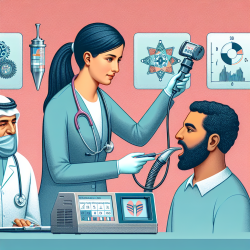Introduction
The intersection of genetics and eye movement research offers promising avenues for understanding and improving therapeutic outcomes in psychotic disorders. The study titled Genome-wide association studies of smooth pursuit and antisaccade eye movements in psychotic disorders: findings from the B-SNIP study provides a data-driven exploration into how genetic variations affect eye movement control, a critical neurophysiological function impaired in psychotic disorders.
Understanding the Study
The B-SNIP study examined 849 participants, including individuals with schizophrenia, schizoaffective disorder, psychotic bipolar disorder, and healthy controls. The research focused on three eye movement phenotypes: initial sensorimotor processing, sustained pursuit maintenance, and voluntary inhibitory control. These phenotypes were analyzed in relation to genetic data, revealing significant associations with specific genetic variations.
Key Findings and Their Implications
- Initial Sensorimotor Processing: Significant associations were found with the IPO8 gene, which plays a role in nuclear-cytoplasmic transport and gene silencing. This suggests potential pathways for therapeutic interventions targeting rapid sensorimotor processing deficits in psychotic disorders.
- Sustained Pursuit Maintenance: The study identified suggestive associations with the SH3GL2 gene, linked to synaptic vesicle endocytosis and neurotransmitter release. Understanding these associations can guide the development of therapies aimed at enhancing cognitive predictions of target motion.
- Voluntary Inhibitory Control: Associations with a non-coding region on chromosome 7 were observed, highlighting potential genetic underpinnings of antisaccade error rates. This insight can inform strategies to improve inhibitory control in affected individuals.
Practical Applications for Practitioners
Practitioners can leverage these findings by integrating genetic insights into their therapeutic approaches. For instance, therapies could be tailored to address specific genetic vulnerabilities, potentially improving outcomes for children with psychotic disorders. Additionally, understanding the genetic basis of eye movement control can aid in the early identification of at-risk individuals, allowing for timely intervention.
Encouraging Further Research
While the B-SNIP study provides a foundational understanding, further research is necessary to explore the full implications of these genetic associations. Practitioners are encouraged to contribute to and stay informed about ongoing research efforts, as this will enhance their ability to deliver evidence-based interventions.
Conclusion
The integration of genetic research into therapeutic practices holds significant promise for improving outcomes in psychotic disorders. By understanding and applying the findings from studies like the B-SNIP, practitioners can enhance their skills and provide more targeted, effective interventions.
To read the original research paper, please follow this link: Genome-wide association studies of smooth pursuit and antisaccade eye movements in psychotic disorders: findings from the B-SNIP study.










